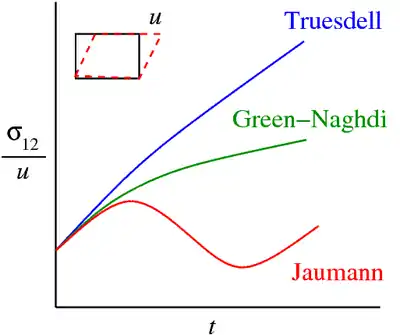Objective stress rates
Many constitutive equations are given in rate form as the relation between a stress rate and a strain rate (or the rate of deformation). We would like our constitutive equations to be frame indifferent (objective). If the stress and strain measures are material quantities then objectivity is automatically satisfied. However, if the quantities are spatial, then the objectivity of the stress rate is not guaranteed even if the strain rate is objective.
Under rigid body rotations, the Cauchy stress tensor transforms as
Since is a spatial quantity and the transformation follows the rules of tensor transformations, is objective.
However,
or,
Therefore the stress rate is not objective unless the rate of rotation is zero, i.e. is constant.
There are numerous objective stress rates in the literature on continuum mechanics - all of which can be shown to be special forms of Lie derivatives. However, we will focus on three which are widely used.
- The Truesdell rate
- The Green-Naghdi rate
- The Jaumann rate
Truesdell stress rate of the Cauchy stress
The relation between the Cauchy stress and the 2nd P-K stress is called the Piola transformation. Recall that this transformation can be written in terms of the pull-back of or the push-forward of as
The Truesdell rate of the Cauchy stress is the Piola transformation of the material time derivative of the 2nd P-K stress. We thus define
Expanded out, this means that
where the Kirchhoff stress and the Lie derivative of the Kirchhoff stress is
This expression can be simplified to the well known expression for the Truesdell rate of the Cauchy stress
|
Truesdell rate of the Cauchy stress |
Proof:
We start with
Expanding the derivative inside the square brackets, we get
or,
Now,
Therefore,
or,
where the velocity gradient .
Also, the rate of change of volume is given by
where is the rate of deformation tensor.
Therefore,
or,
You can easily show that the Truesdell rate is objective.
Truesdell rate of the Kirchhoff stress
The Truesdell rate of the Kirchhoff stress can be obtained by noting that
and defining
Expanded out, this means that
Therefore, the Lie derivative of is the same as the Truesdell rate of the Kirchhoff stress.
FFollowing the same process as for the Cauchy stress above, we can show that
|
Truesdell rate of the Kirchhoff stress |
Green-Naghdi rate of the Cauchy stress
This is a special form of the Lie derivative (or the Truesdell rate of the Cauchy stress). Recall that the Truesdell rate of the Cauchy stress is given by
From the polar decomposition theorem we have
where is the orthogonal rotation tensor () and is the symmetric, positive definite, right stretch.
If we assume that we get . Also since there is no stretch and we have . Note that this doesn't mean that there is not stretch in the actual body - this simplification is just for the purposes of defining an objective stress rate. Therefore
We can show that this expression can be simplified to the commonly used form of the Green-Naghdi rate
|
Green-Naghdi rate of the Cauchy stress where . |
The Green-Naghdi rate of the Kirchhoff stress also has the form since the stretch is not taken into consideration, i.e.,
Proof:
Expanding out the derivative
or,
Now,
Therefore,
If we define the angular velocity as
we get the commonly used form of the Green-Naghdi rate
Jaumann rate of the Cauchy stress
The Jaumann rate of the Cauchy stress is a further specialization of the Lie derivative (Truesdell rate). This rate has the form
|
Jaumann rate of the Cauchy stress where is the spin tensor. |
The Jaumann rate is used widely in computations primarily for two reasons
- it is relatively easy to implement.
- it leads to symmetric tangent moduli.
Recall that the spin tensor (the skew part of the velocity gradient) can be expressed as
Thus for pure rigid body motion
Alternatively, we can consider the case of proportional loading when the principal directions of strain remain constant. An example of this situation is the axial loading of a cylindrical bar. In that situation, since
we have
Also,
Therefore,
This once again gives
In general, if we approximate
the Green-Naghdi rate becomes the Jaumann rate of the Cauchy stress
Other objective stress rates
There can be an infinite variety of objective stress rates. One of these is the Oldroyd stress rate
In simpler form, the Oldroyd rate is given by
If the current configuration is assumed to be the reference configuration then the pull back and push forward operations can be conducted using and respectively. The Lie derivative of the Cauchy stress is then called the convective stress rate
In simpler form, the convective rate is given by
Caveat on objective stress rates
The following figure shows the performance of various objective rates in a pure shear test where the material model is a hypoelastic one with constant elastic moduli. The ratio of the shear stress to the displacement is plotted as a function of time. The same moduli are used with the three objective stress rates.
 Predictions from three objective stress rates under shear |
Clearly there are spurious oscillations observed for the Jaumann stress rate. This is not because one rate is better than another but because its is a misuse of material models to use the same constants with different objective rates.
For this reason, a recent trend has been to avoid objective stress rates altogether where possible.